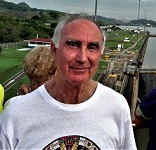


|
|
|
|||||||||||||||
|
|
||||||||||||||||
|
|
|||
|
|
Panama Canal
The Panama Canal stretches 40 miles (65km) across the Isthmus of Panama and connects the Pacific and Atlantic Oceans. It is one of the largest and most difficult engineering projects ever undertaken. Originally conceived by the Spanish in 1524 as a way of reducing the time taken in shipping the treasures of the Americas to Spain, it was not until 1881 that the project was started by the French under the supervision of Ferdinand de Lesseps following his success in constructing the Suez Canal. Due to the technical and financial difficulties and the loss of over 25,000 lives due to Yellow Fever and Malaria it was abandoned by the French in 1888. In 1903 they sold their interest to the United States who saw the military advantages in its use and started work on it in 1904. The canal was originally to be at sea level, but the US changed that to the use of locks due to the vast amount of earth that would have needed to be moved and the fact that there is a difference of tide levels between the Pacific and Atlantic Oceans which would have created problems in its’ navigation. Before work could start it was necessary to eradicate the threat of disease, so a mammoth operation was undertaken to do that by William C. Gorgas who eradicated disease along the planned route. A railway was constructed by John F. Stevens to take in the men, materials and machines and to remove the vast amounts of excavated earth. More than 100 million cubic yards of spoil was produced. This was used in the construction of the dam which was to form a Lake, the creation of a breakwater and the reclamation of land from the sea. The remainder was deposited in a dump site in the jungle. The engineering projects required the damming of the Chagres River to form the 163 square miles Gatun Lake; cutting through the continental divide; and the construction of three sets of locks situated at the towns of Gatun, Pedro Miguel and Miraflores, these were carried out by George W. Goethals. The locks are designed to lift the ships 85 feet (26 metres) enabling them to sail across the isthmus and lower them down on the other side. Each lock chamber of the three locks is 110 feet (33.5 metres) wide and 1,000 feet (305 metres) long, a size which was determined by the largest American warship, and the largest passenger ship that was to be constructed, the Titanic. The locks gates, or mitre gates as they are known, close in a wide 'V', swing open and shut like double doors. They are seven feet (2 metres) thick of hollow construction, which gives them buoyancy and reduce the stress on the hinges. 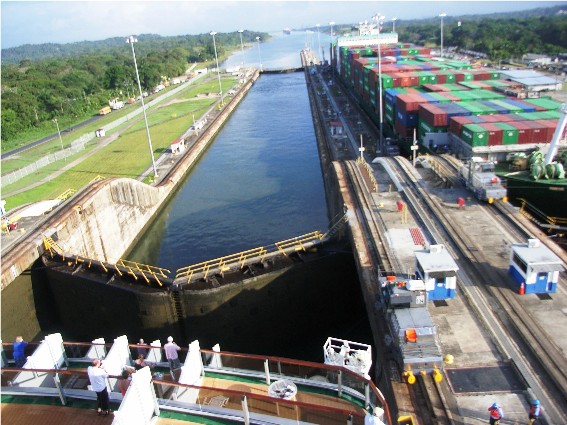  For a ship to move through the lock the lock gate opens, and the ship moves in. The gate closes behind it and the water level is lowered or raised. It takes about half an hour to get the water in or out to raise or lower the ship. The gate is then opened, and the ship moves out of the chamber. 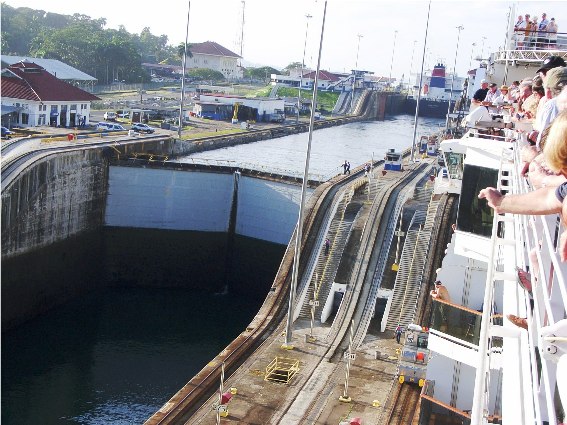 The locks work purely on gravity with water being supplied from the Gatun Lake resulting in - each time a ship uses the canal - 52 million gallons of fresh water being emptied into the ocean. A new series of locks were constructed in 2016 to enable larger ships to use the canal and the new locks incorporate water basins that reuse the water. The first complete Panama Canal passage by a self-propelled, ocean-going vessel took place on 7 January 1914 by an old French crane boat, the Alexandre La Valley, although the first official trip was made by the canal cement boat, Ancon; This was a low key affair due to the first world war. Some 13 to 14 thousand vessels use the Canal every year which amounts to an average of 30 a day amounting to approximately 5% of the world trade. The final cost of construction for the canal was $380 million, which by today’s prices would be $17 billion. Ships can traverse the canal in either directions from the Atlantic or from the Pacific Ocean. Approaching the canal ships will pick up the pilot who takes full command of the ship. When near the entrance they are met by a small boat who takes the ships line and passes it to the electric mules, which control the ship while in the lock.  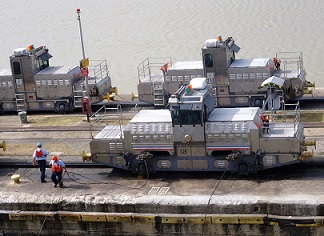 Ships entering the canal from the Atlantic do so at the Gatun Lock.  The Gatun lock consist of three lock chambers. A ship is raised or lowered 85 feet (26 Metres) in a continuous flight of three steps. Once through the Gatun Lock the ship enters the Gatun Lake. 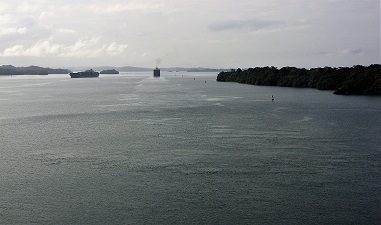 The Gatun Lake is 85 feet (26 metres) above sea level and was created by the construction of the earthen dam across the Chagres River adjacent to Gatun Locks. The two wings of the dam and the spillway have an aggregate length of about one and a half miles. The dam is nearly a half mile wide at the base, sloping to a width of 100 feet (30.5 metres) at the crest, The lake covers an area of 163 Square miles and is used to travel a distance of just over 23 miles (37 km) from Gatun Locks to the north end of Gaillard Cut, which is also known as the Culebra Cut. 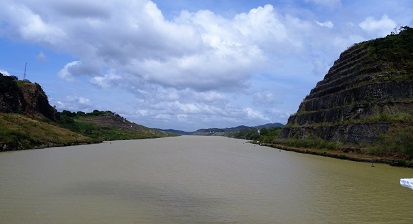 This was the most challenging part of the construction as it involved cutting an 8 mile (13 km) long channel through the rock and shale of the mountains of the Continental Divide. It has undergone a number of widening sessions firstly in 1930s then in the 1990s and again prior to 2015 and the construction of the new locks.  Due to landslides and silting it is a continuous process of dredging and keeping the canal free from obstructions, in order to ensure a year-round minimum draft. This used to be 39.5 feet (12 metres) even during dry periods, but this was increased with the new larger ships being able to use the canal since the construction of the additional locks. 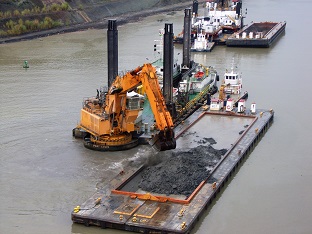 The Gaillard Cut runs from the Gatun Lake to the north end of the Pedro Miguel Locks. 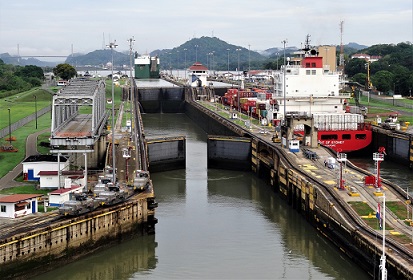 The Pedro Miguel Locks consist of one step which lowers a ship 31 feet (9.5 metres) to the Miraflores Lake. This is a small artificial body of water a mile wide that separates the two sets of Pacific locks, the Pedro Miguel and the Miraflores Locks The Miraflores Lock has 2 steps. The chamber gates are the tallest of any of the canal's locks because of the extreme variation in the pacific tides, which is 20 feet (6 metres). The Lock has a set of intermediate gates so that when a ship is small enough, these gates can be used, which reduces the size of the chamber and so conserves water. 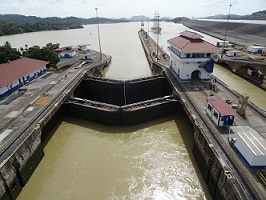 The Miraflores Lock also has a museum which display items explaining how the canal functions and a viewing station, which gives people the opportunity to see the locks in action even if they are not travelling through the canal. 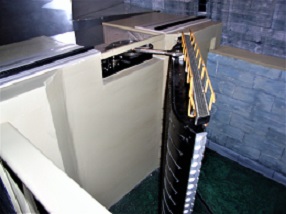 Electric floodlights were installed in 1963 which allows the canal to be used 24 hours a day. The Canal generates its own electricity by way of hydroelectric generators at the Gatun and Miraflores ends. 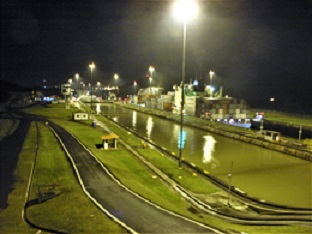 In 2006 Panama decided to expand the Panama Canal to allow for more transits and bigger ships. The program required the construction of two new sets of locks - one on the Pacific and one on the Atlantic side of the Canal. Each lock would have three chambers and each chamber was to have three water re-utilization basins. It also required the construction of a new 3.8 miles (6.1 km ) long access channel. The program also entailed the widening and deepening of existing navigational channels. The work took eight years to complete at a cost of $5.25 billion. It was anticipated that commercial transits would begin mid-2015. but the opening was delayed due to cracks in the concrete walls – and didn’t open until April 2016. Currently, over 5 percent of all world trade passes through the Panama Canal.
To see more photographs and take a virtual tour of the site click on the photoshow below.
Addition information can be seen on Encyclopaedia Britannica |
|
|
|
|
|||
All Photographs were taken by and are copyright of Ron Gatepain
| Site Map |
